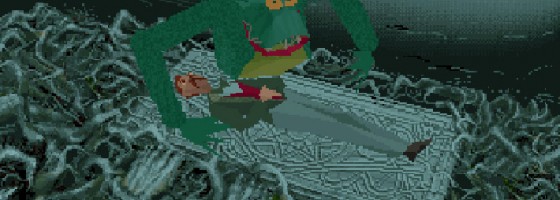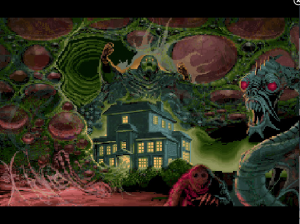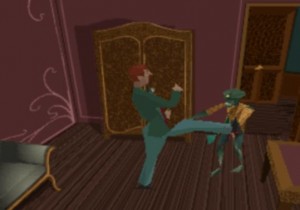For the first letter in our series, it’s fitting that we talk about the game that started the survival horror craze: Alone in the Dark.
Alone in the Dark was developed by Infogrames in 1992 tasked players to solve the mysterious murder of Jeremy Hartwood, who lived in Derceto Mansion.
At this point in the industry, the adventure genre was in full bloom with many now considered classic series such as King’s Quest. Most adventure titles were designed with a point and click interface or text based with a prominent focus on puzzles.
Unlike those adventure games, Alone in the Dark mixed things up by giving the player direct control over their character. You could run, throw, use, attack and other commands in an attempt to solve the mansion’s challenges. Enemies would attack the player forcing them to defend themselves with weapons and even their fists, a far cry from static roadblock type enemies.
For people wanting to be challenged with puzzles, Alone in the Dark featured a wide assortment of death traps and locked doors. One thing to remember was that adventure games back then were a lot more brutal then the ones today. It was expected to run into a challenge that could kill you, forcing you to reload a save or restart a game. One of the items in the game was a “death book” that would kill the player if they tried to read it for instance.
Enemies in Alone in the Dark were put into two groups: unique enemies and grunts. The grunts were zombies and dog like creatures that could come out of nowhere to attack the player.
These enemies required the player to use their weapons to take them out, such as guns or swords, or simply fight them hand to hand.
Unique enemies were special enemies that were in specific rooms. Some of them were deathtraps that would kill the player if they did something wrong. While others guarded areas and required special methods to take them out.
What makes Alone in the Dark an important game to know was that it became the blueprint for the survival horror genre for years to come.
The combination of action gameplay with puzzle solving separated it from titles that only focused on one or the other.
Giving the player more control over their character compared to an adventure title, made the situation more frightening, since the player was in direct control compared to a point and click interface. And the puzzle solving reinforced the detail that you couldn’t solve all your problems with violence.
Over the years we’ve seen a number of survival horror titles released using the Alone in the Dark formula: From Resident Evil, to Silent Hill among others.
In fact, Alone in the Dark remained the model for horror titles up until 2005 when Resident Evil 4 modernized the genre, for better and worse. This was the moment when survival horror started to veer more into action horror. Still, having a 13 year impact on a genre isn’t exactly a bad thing.
Following Alone in the Dark, there have been several sequels made in an attempt to continue the franchise. But with exception to a few unique twists with the most recent one, they are pretty forgettable.
While the survival horror genre has moved on from the days of Alone in the Dark, it still remains an important game to understand. As it was one of the first of many early titles that combined genres to create something new.
Click here to return to the series main page
Up next: the letter B




Pingback: Game Design Encyclopedia Volume 1: The Foreword | Game Wisdom()